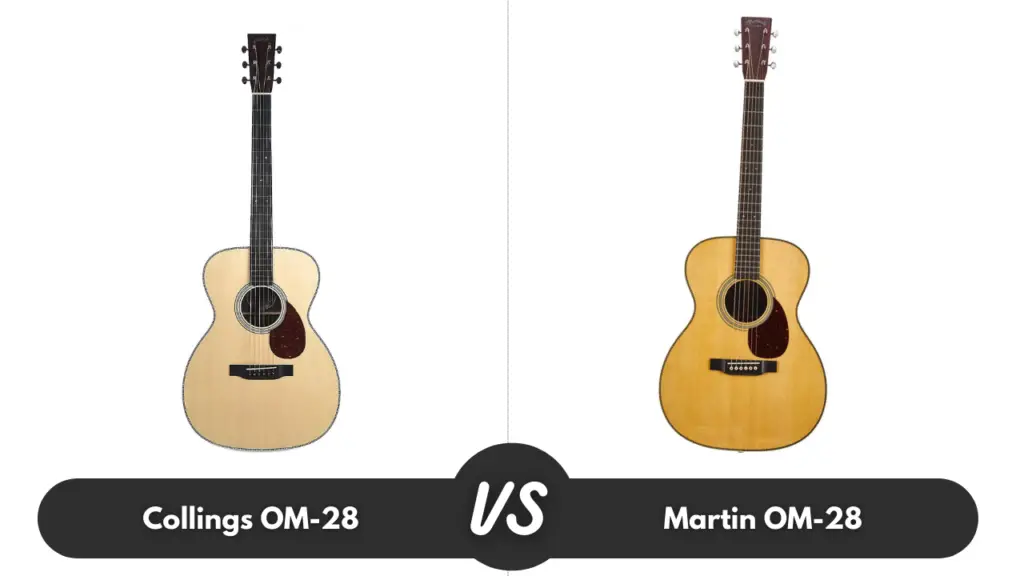| Features: | Collings OM-28 | Martin OM-28 |
|---|---|---|
| Bracing: | Pre-war scalloped X-brace | Scalloped X |
| Top: | Sitka spruce | Sitka spruce |
| Back & Sides: | E. Indian rosewood | E. Indian rosewood |
| Frets: | 20 | 20 |
Collings OM-28
Collings has been one of the USA’s highest regarded makers of acoustic guitars.
If money was no object, then today is a great time to be in the market for an acoustic guitar. Boutique brands are producing some superb instruments. Even though Collings is a smaller maker, and neither a ‘one man in a shed’ boutique operation nor a big company with a production line, they are offering guitars that the cognoscenti reckon are among the best ever made.
Build
Collings’s OM2H is a relatively restrained-looking guitar and from the moment you pick it up and take a close look, you will be able to appreciate its superb craftsmanship and the attention to detail that Collings has become famous for.
As the OM2H is aimed at professionals and highly experienced players, Collings offers quite a few options. An example of what Collings offer is a fine quality sunburst finish and Adirondack spruce, pre-war style, scalloped X bracing, as opposed to the standard bracing, which is made from Sitka spruce. While you could save quite a bit of money by choosing neither of these options, the sunburst looks fabulous and upgraded bracing does seem to make a real difference to the tone. It’s to be expected with a guitar at this level – small differences affecting what is already a refined performance that experienced players will be able to recognise and appreciate.
Built to the highest standard from the finest materials, for a go anywhere, play just about any kind of music, the 14-fret OM2H is a serious acoustic guitar for serious players.
Performance
Fans of OM bodies have described the style’s tonal tendencies as “piano-like,” and it’s not hard to hear that. The tones of the OM2H are dense and complex in the best way, with an especially prominent second (octave) harmonic, especially on the bass strings. Its mids never feel crowded, while giving a wealth of energy in that register. The resulting tones can feel warmer than those from 000-type guitars although there’s no shortage of high-end shimmer.
The OM2H sounds great for many styles and techniques, from crude cowboy chords to fleet flat-picked lines to refined fingerpicking.
If you enjoy playing fingerstyle, you’ll be pleased to know that the wide, touch-responsive dynamics amplify every nuance of fingerstyle playing. It gives a complex low-midrange character making solo playing sound massive, but some of that particular character might be obscured in ensemble contexts.
Martin OM-28
90 years on and Martin has brought their OM bang up to date, with a combination of player-focused upgrades along with some of the vintage-accurate features we crave.
It’s good to see Martin giving a bit of love to its Standard line models, and not just concentrating on the super-high-end stuff such as their Authentic and signature models.
Build
The Materials used for the OM-28 feature the usual 28-style appointments applied with solid Indian rosewood back and sides, Sitka spruce top and bracing, and ebony fingerboard and bridge. It also features what Martin refers to as a ‘select hardwood’ neck – which looks much like mahogany.
The headstock overlay of the guitar is rosewood, while the nut (44.45mm) and saddle (intonation compensated) are both bone. The tuners are Schaller’s take on the classic open-gear Waverleys that can be found on Martins of yore. The overall build is, as you would expect, for almost three grand, superlative in and out.
As Martin’s most elegantly proportioned design, their new OM-28 ticks pretty much every box. Unlike common rivals such as Gibson, the OM-28 provides more overtly styled offerings, everything about it whispers subtlety and taste. Its curvy outline is enhanced by the attractive herringbone binding and a dapper ebony fingerboard with neat abalone diamonds and squares. Even the OM-28’s rosewood headstock overlay and faux-tortoise pickguard require scrutiny to really appreciate their beauty.
Performance
The Reimagined OM-28 is an absolute joy to play. The first port of call is, of course, the open-position shapes that most guitarists spend most of their time on, and the wider nut provides bags of space for comfortable chording. Once you’ve put a capo on at the 7th fret, it certainly felt easier to play than a D-28 Authentic, which is not only wider but deeper at that point. This lesser flaring with a longer scale may also make the perceived difference between near-the-nut chords and those fretted further up less clear, although you’d need to play one to make up your own mind about that.
Sonically, the OM-28 gives an interesting mix. Against an identical D-28 its tone is more focused, with a slightly reduced bottom end, but more pronounced mids giving the OM-28 projection and real cut-through – exactly what it was designed to do in the orchestras of the day.
This does give the OM-28 a less ‘warm and cuddly’ voice – indeed a similar mahogany D-18 would probably prove a better sofa companion and all-around good egg. But if you require a guitar that does what the OM-28 does, which is to protect your fingerpicking, strum like a trimmed-down dreadnought and punch right through the mix, then you’d struggle to find a better choice.
Conclusion
Collings OM-28 will have a superb fit and finish, while Martins OM2H will be a bit less “perfect” in regards to craftsmanship. The Collings OM-28 has a characteristic tone that many people enjoy.
So, should you buy the Martin? It’s pretty much impossible to advise which brand or model to go for given that most Martins sound good in their own way.
